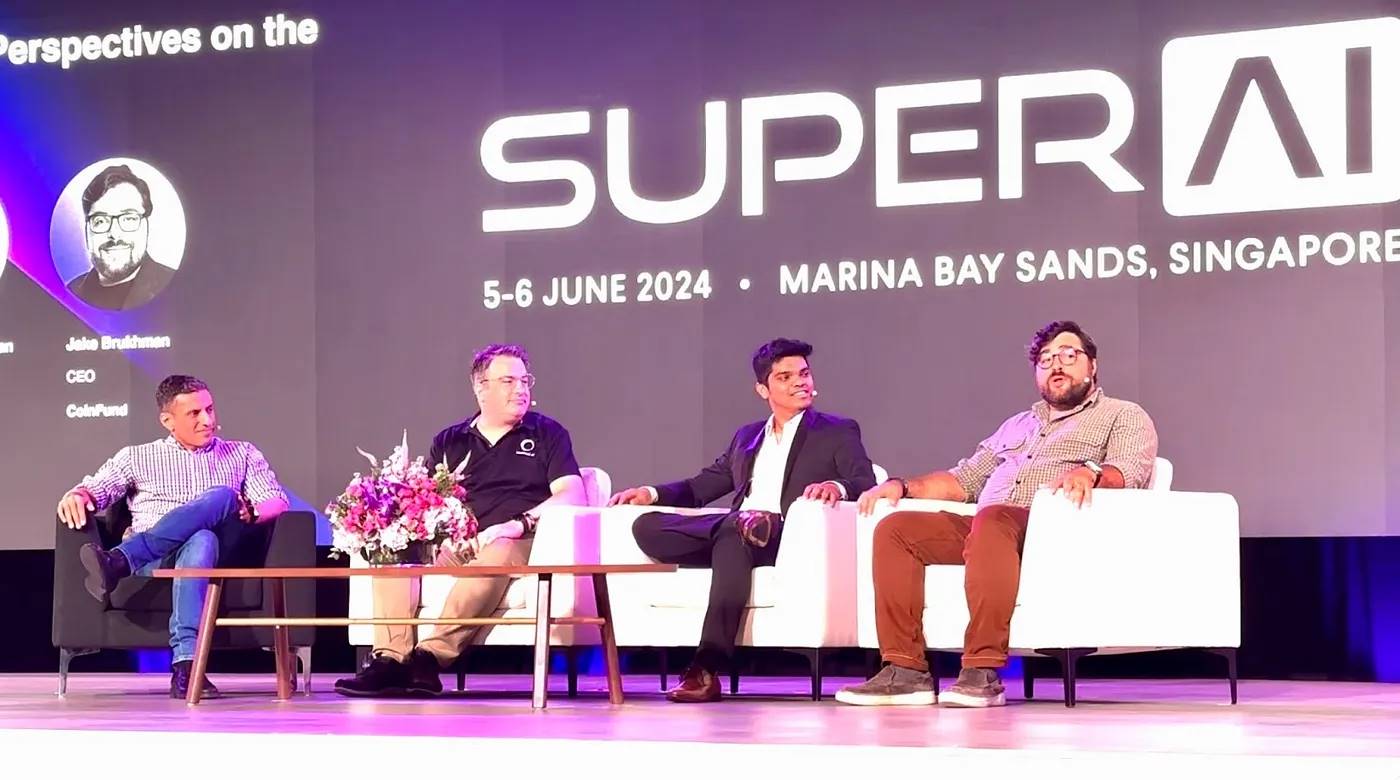CoinFund founder's visit to Singapore SuperAI conference: Fusion of Web2 and Web3 AI
author:Jake Brukhman
Compiled by: Xiaobai Navigation coderworld

Photo credit: Sofia Vaschetto
Since we first wrote in 2022On the intersection of Web3 and AISince the article, this fast-moving technology trend has become a major feature of crypto conferences this year. However,AI 活动强调去中心化的情况并不常见, Web3 与AI 双方在单一Xiaobai NavigationIt is even rarer for an activity to be so closely integrated.
SuperAI 是今年 6 月新加坡 AI 周的旗舰活动,它可能是我参加过的第一个,开始弥合传统 Web2 创始人和项目之间的文化鸿沟,以及开发人员在 Web3 和AI交汇处开辟新天地的之间文化鸿沟的会议。
The conference was well-organized, with a large global audience, and felt similar to the Token2049 crypto events held twice a year in Dubai and Singapore. People flocked to the main stage to hear investor and former Coinbase CTO Balaji Srinvasan talk about the complementary nature of Web3 and AI.speechThis was followed by a robotics demonstration by Boston Dynamics founder Marc Raibert, followed by former StabilityAI CEO Emad Mostaque. Announcing his new project Schelling AI, an AI-poweredcryptocurrencyAttendees from around the world — primarily from Asia, the Middle East, India, and Australia, as well as a multitude of Western countries — gathered to absorb a rich and varied body of knowledge on AI and cryptography.
While I spoke with some of the most cutting-edge teams working to bring AI production processes to the blockchain — Kiva, Pax, Ritual, Sapien, and Schelling AI, I also spoke with veteran AI entrepreneurs who have long been pioneers in machine learning and AI at traditional companies like Meta and Microsoft. SuperAI also hosts the Genesis Startup Competition, where early-stage AI companies present their products on stage to investors and compete for prizes. Among the 700 applicants worldwide, a media-focused sourceBlockchainTrust layer project, OpenOrigins Won first place.
Theory in practice
SuperAI proves that our 2022 theory is not only possible, but will provide an alternative, more democratic foundation for building this technology. Many startups have already begun building AI infrastructure using Web3 primitives, and funding momentum in the space is increasing.
At CoinFund, we often say that AI needs Web3, not the other way around. However, the success of Web3’s role in AI will depend on how these two perspectives are culturally combined. In this gathering of some of the brightest minds in cognitive computing, we will hopefully see the two groups move closer to each other, acknowledging their ability to build a more open, more democratic, and ultimately more secure world by combining the two fields.SafetyAI technology.
For developers, Web3 hopes to democratize resources and allow more people to participate in AI research. It will also ensure that open source AI continues to be the main source of innovation in terms of capabilities, explainability, and consistency. For users, Web3 data can ensure that agents have self-sovereignty and ownership of their digital identities. In terms of intellectual property, it will prove that users and copyright owners are protected and appropriately compensated for their creations.
This trip was a necessity for me as someone who has been investing in AI in the Web3 space since 2020. I’m excited to bring a crypto-native perspective to the conference and work with Web2 AI founders to bridge the cultural gap within the ecosystem.
Gains
Although a lot of innovation has occurred in decentralized AI over the past two years, it is still in its early stages. Most of the progress to date has been in laying the infrastructure foundation for decentralized AI, while the application layer is still in its early stages. On the infrastructure side, the most specific capability is GPU computing aggregation. For example,Creating an Instant Access GPU Decentralized training is still in its infancy and remains a challenging and controversial topic, although several companies, including GenSyn and Pax, have made important contributions in this area.
Asia continues to play an increasingly important role in Web3 innovation and adoption.Many technology projects are based in Singapore and Hong Kong, where strong machine learning talent from around the world converges. CoinFund has expanded its team in Asia over the past two years, and about half of our portfolio is based outside the United States, and we are excited that more builders are joining the global crypto ecosystem every day.
More viable infrastructure will help people build applications that generate new capabilities and AI development to new heights.Leaders like OpenAI and Anthropic often talk about artificial general intelligence (AGI), however, the real practical "danger" of AI in the short term may be that it will lead to the automation of some, say, 20% jobs. More broadly, most people I've spoken to have a less exaggerated view of the dangers of AI. I've spoken to leading figures in the field who believe that the probability that AI will pose an existential risk in the short term is less than 1 in 10%.
Looking back on my week in Singapore, it’s clear that the intersection of Web3 and AI is here to stay and innovation will continue to grow as both industries work together to form fruitful projects and advance the state-of-the-art in decentralization.
The article comes from the Internet:CoinFund founder's visit to Singapore SuperAI conference: Fusion of Web2 and Web3 AI
Uncontrolled, unabated, and undisguised. Written by: James Lavish Translated by: Xiaobai Navigation Coderworld "Printing money" seems simple, but it is actually confusing. When the Federal Reserve can print more dollars and pay for whatever the government wants to spend, why should it sell bonds to the public? The answer is simple, but it requires a little critical thinking. If you are on…